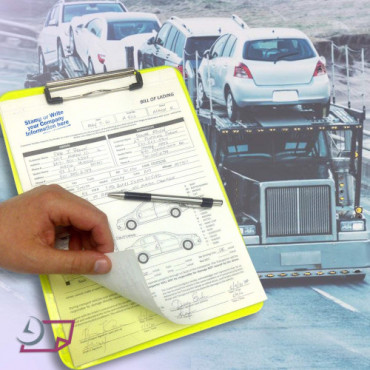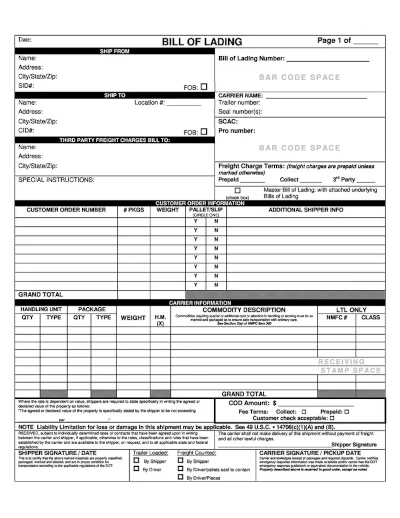Bill of lading auto transport

If you are getting ready to have your automobile shipped, you should familiarize yourself with the documents that will be exchanged between you and the auto shipping service. Among these is the bill of lading. The bill of lading serves as a legal contract between you and the auto shipping company. In the unlikely event that any damages are incurred during transport, bills of lading completed during pickup and delivery can help prove the condition of your automobile changed during the transportation. Please make sure that the condition of the vehicle recorded on the bill of lading is complete and accurate. The law requires that the bill of lading must be signed by both the owner of the automobile and the driver hauling the shipment upon both pickup and delivery. A copy of this document should be provided to both sides. For those who are new to auto shipping, let’s take a closer look at the bill of lading and its role in the car shipping process.
When is a bill of lading auto transport filled out?
A bill of lading should be completed during pickup and delivery. This means that for a shipment you should have two bills of lading - one from pickup and one from delivery. You should carefully inspect your automobile and review the bill of lading with your auto shipping service. Don’t sign a bill of lading that you don't agree with. If you have any questions or concerns regarding your bill of lading, contact your car shipping company. In addition to filling out the bill of lading with your auto transport service, it is highly recommended to take some photos or a video and perform a complete inspection of the vehicle. This extra documentation ensures that the condition of your automobile before and after transport is clear. Remember to keep a signed copy or photo of the bill of lading for your records.
Details about the car shipping company
The first section of the bill of lading for auto transport contains general information about the car shipping company such as the name of the company, their legal address, a valid contact number, and details about the specific driver hauling your automobile.
General vehicle information
The bill of lading will also contain general information about your automobile. It includes the make, model, color, license plate number, and VIN number of your vehicle. This information is used to ensure the right vehicle is being transported.
Condition of the automobile
Right before your automobile is loaded onto the truck, both you and the transport driver will conduct an inspection and make notes of any dings, dents, scratches, or other damage to the vehicle. As mandated by federal law, the odometer reading will also be noted. This same inspection will be performed upon delivery of the automobile and both the owner and the transport driver will sign the bill of lading at both pickup and delivery.
Pickup instructions
 Your bill of lading is your receipt and your evidence of the condition of your automobile. Take time to walk around your vehicle with the car shipping service to accurately document any existing damages to your vehicle’s exterior on your bill of lading. It is highly recommended to take detailed photos or videos of your automobile as well. You should also make sure that the vehicle condition recorded on the bill of lading is complete and accurate. Your signature on the bill of lading is your agreement to the vehicle condition prior to transport. Don't sign an auto transport bill of lading form that you do not agree with. If you have any questions or concerns regarding your bill of lading, contact your car shipping service. If you are electing to have someone else handle the vehicle pickup on your behalf, make sure to share these instructions with them and stress their importance.
Your bill of lading is your receipt and your evidence of the condition of your automobile. Take time to walk around your vehicle with the car shipping service to accurately document any existing damages to your vehicle’s exterior on your bill of lading. It is highly recommended to take detailed photos or videos of your automobile as well. You should also make sure that the vehicle condition recorded on the bill of lading is complete and accurate. Your signature on the bill of lading is your agreement to the vehicle condition prior to transport. Don't sign an auto transport bill of lading form that you do not agree with. If you have any questions or concerns regarding your bill of lading, contact your car shipping service. If you are electing to have someone else handle the vehicle pickup on your behalf, make sure to share these instructions with them and stress their importance.
Terms and conditions
Finally, the bill of lading will include the specific terms and conditions agreed upon by both the owner of the automobile and the auto transport company. This will include payment information, insurance information, and any special requirements. It also includes clauses related to payment, including acceptable forms of payment, advance payment, and actions that may cause penalties. As you can see, the bill of lading is a very important document that serves as a legal contract between the shipper and the auto transport company. You and your transport driver are required to sign an auto transport bill of lading forms before moving forward with the auto shipping process. By signing this document, you are agreeing to all of its contents. Therefore, read through the bills auto transport carefully to avoid any misunderstandings.
Delivery instructions
Review the bill of lading with your auto transport service and compare the current state of your automobile to the images or videos you took on pickup day. This is your opportunity to document damages in the unlikely event that any are incurred during transport. You should also make sure any damages are clearly noted on the bill of lading. Make sure that the vehicle condition recorded on the bill of lading is complete and accurate. Your signature on the bill of lading is your agreement to the vehicle condition post transport. Do not sign a bill of lading form for auto transport that you do not agree with. If you are electing to have someone else handle the vehicle delivery on your behalf, make sure to share these instructions with them and stress their importance. And again, if your bill of lading is electronic such that the carrier is not able to hand you a copy of it, please take a picture of it for your own records.
